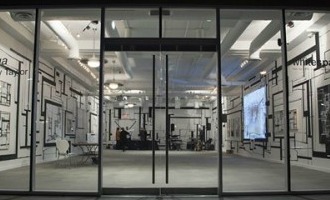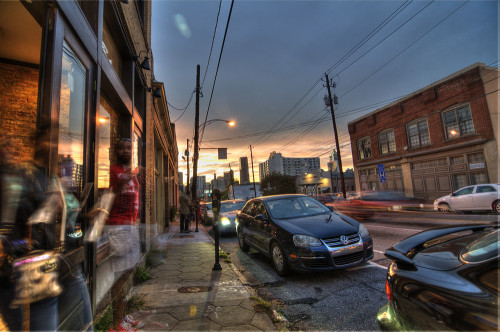
In recent years, art and real estate have become bedfellows, as the former is often used to sell the latter. In Atlanta, agents, brokers, and developers are partnering with artists and galleries to bring contemporary art into vacant or available property. The goal, of course, is to move the real estate, though artworks often find buyers in the process. The tactic is more complicated than hanging a picture on a wall in an empty building or staging a residence. Does contemporary art actually add value to real estate?
In Miami, some real estate groups have become intertwined with the art scene. They sponsor collateral events that attract wealthy art collectors to fairs such as Art Basel Miami Beach or to big events like the opening of the Perez Art Museum Miami. (In a different marriage of art and real estate, the museum is named for Jorge Perez, a luxury condominium builder and CEO of the Related Group, who donated an estimated $40 million in cash and art to the Miami Art Museum, which was controversially renamed for the billionaire.) “Every building I can think of that has invested in extraordinary art in their public areas has never had a problem selling and never had a problem reselling,” said Mark Zilbert, president and chief executive of Zilbert International Realty, a Miami Beach-based firm that specializes in high-end properties. Those that are associated with fine art “tend to have the highest market value,” he told the Miami Herald in a November 2013 article about how fine art is used to sell condos in South Florida.
In Atlanta, this model is catching on. In 2012, the Ansley Group at Harry Norman Realtors, an affiliate of Christie’s International Real Estate, collaborated with Bill Lowe Gallery to host an art event at the home of Atlanta Braves pitcher Derek Lowe. The home was listed at $3.5 million and staged with impressive sculptures and over two million dollars’ worth of contemporary art, including works from such artists as Thorton Dial and Hiro Yamagata. About 300 people attended. “Tens of thousands of dollars [of art] sold that night,” said Bonneau Ansley, a broker at the Ansley Group. According to Ansley, the house sold to someone who attended but was not actually house hunting. According to public records, Lisa Jackson paid $2.8 million for Derek Lowe’s home.
In December, the Stacks Lofts + Artists Tour invited paying participants to tour the homes of artists who live in the Cabbagetown lofts, such as Tre Wynn, Dan Snyder, and Darby Jones, as well as other vacant units hung with art for the event. For $10, attendees could view units staged with works by local artists and savor goodies from restaurants such as Agave and Doc Chey’s Noodle House. A representative from the Stacks, a converted 19th-century cotton mill, was not available for comment.
Atlanta creatives are quick to say that this practice is not all about turning a profit. “Contemporary art does not have to be an intimidating white-cube experience,” says artist Romy Maloon, who is the program expansion manager for the nonprofit Dashboard Co-op, which since 2010 has mounted temporary exhibitions in vacant spaces. These sites “can be fun and accessible, and you can still deal with serious conceptual issues while creating an entertaining environment for your audience.”

Founded by Beth Malone and Courtney Hammond to promote emerging artists, Dashboard Co-op has had 12 exhibitions in 12 properties, 11 of which were leased to new businesses shortly after. But the idea to use vacant spaces arose from need, not a desire to promote real estate; the organization started with a shoestring budget that barely covered the cost of insurance, artist stipends, and other expenses. Paying rent would be prohibitive. “Dashboard initially began hosting shows in these spaces because when we started we had no money and no clout, and these were spaces that were given to us,” Maloon says. “We went into smelly warehouses because they were big and (the owners) let us do what we wanted with them.”
A site-specific installation and exhibition of new works by Tommy Taylor was recently on view [January 24-March 1] in a vacant space at Ponce City Market, which was a collaboration with Whitespace Gallery. Phase one of the massive construction project, which will transform the 1.1-million-square-foot Sears, Roebuck & Company building into restaurants, retail and office spaces, and apartments, is scheduled to open this fall.
“Certain off-site installations can provide an artist with a lot of freedom to think about the work and how it relates to that space,” said Susan Bridges, owner of Whitespace. Taylor had begun creating works on paper that consisted simple marks on a white background, she said. “It was pretty clear that he would create an environment that would enhance his mark making and take it to another level. The concept was that you were walking into a painting.”
Could showing work in commercial spaces help to democratize the art experience? Taylor seems to think so. “Simply put, more eyes on the work means greater exposure,” he said. “Like a snake eating its own tail, the art world has become a self-contained, self-referential, and esoteric entity that has a tendency to be off-putting to the general public. Exhibiting in these, as of yet, unused spaces can make the art more accessible to people who may not make going to museums or galleries a part of their Saturday. There are so many creative people in Atlanta doing wildly creative things that are not being seen by enough people.”

Taylor’s exhibition opening attracted more than 300 viewers. Of the 14 out of 18 works that sold during the show’s run, most sold on opening night, and an interior designer has commissioned Taylor to create a similar instillation in her home. The developer of Ponce City Market, Jamestown Properties, claims that engaging the creative community does more than sell units. “We embraced the site-specific installation and are excited to be part of something new and immersive. We’re not looking to exclusively hang canvas on walls but rather allow artists to have a dialogue with the space,” said the Jamestown representative. Thus, they plan to host more art events in available spaces.
“I do think it’s a reflection of the community here in Atlanta,” says Maloon of the intersection of art and real estate. “There seems to be a move away from unchecked expansion and unsustainable developments. We don’t need to knock down and build everything ‘new.’ We can transform what exists, as with Ponce City Market or the Beltline, or even with Living Walls painting the exteriors of buildings and structures,” she says. “More and more, I think building owners understand the value of hosting contemporary art in these spaces and helping to change the face of a city.”
Taylor agrees: “I think at street-level this does add real value to our daily lives. My daily experience is being influenced by murals throughout the city that were brought to life by the Living Walls project. Art is a reminder that there is more going on in our human experience than jobs, rent, acquisitions, buildings, telephone poles, traffic, meetings, etc. In lieu of more dedicated public space for art and a funded space for artists, opening these commercial spaces to artists’ visions and for the public’s exposure is a very positive thing.”
Before opening Whitespace, Bridges also curated exhibitions throughout Atlanta in some “funky places.” The canvas, whether hung in a vacant building or a home, has to be displayed with some authenticity, she explains. “I don’t think just having an art show in a vacant, cool space does anything; to me that’s not very interesting,” Bridges says. “Ultimately, it’s all about the concept, the art, and how it relates to the space. There is an audience in Atlanta that is looking for an experience (through art).” This altruistic approach may be valid, but the real estate community is hoping that some lucky patron is willing to pay to make this “experience” home.
Jennifer Jefferson is in the graduate writing program at the Savannah College of Art and Design in Atlanta.
For Sale: Art and Real Estate
Related Stories
Mood Ring
Features
Daily
How To Get Free
Pieced together through collage, video capture, and a spoken poem, artist Kay-Ann Henry presents the intricacies of Afro-religious practices and Jamaica's particular expression of obeah, pocomania, and kumina.
Fictions More Precious by Rodell Warner at Big Medium, Austin
Natalie Willis Whylly explores memory, colonial archives, and encounter in Rodell Warner's Fictions More Precious at Big Medium, Austin.
In the Studio with Chayse Sampy
Amarie Gipson visits mixed-media artist Chayse Sampy in her shared studio in Downtown Houston to discuss living in the South, Afro-surrealism, and the color blue.




